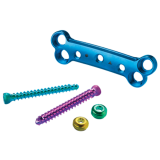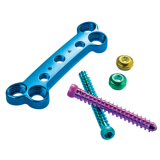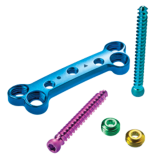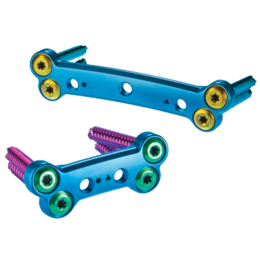Ürün Açıklaması
V2F Anterior Fiksasyon Sistemi tümör ve travma patolojinin yönlü cerrahi tedavisi için yeni nesil enstrümantasyon sağlar.V2F Sistemi tescilli değişken-to-sabit kilitleme kapağı teknolojisi, plaka çeşitli, ve vidalar cerrahlar hasta ve cerrahi bireysel ihtiyaçlarını karşılamak için daha fazla seçenek sunar. Çift kurşun spongioz / kortikal vida daha ekleme hız ve gelişmiş fiksasyon sağlamaktadır. All-Through-One enstrümantasyon hassas vida yerleştirme ve tekrarlanabilir, kontrollü yörünge sunmaktadır. V2F Sistem çoklu seçenekler cerrahlar sunulur – kontrol gücü ve verimlilik kaybı olmadan.
Özellikler
- V2F Sistem patentli teknolojisi cerrahlar bir değişken açılı vida yerleştirin ve ardından plaka yörüngesini kilitlemek için izin verir
- 6mm ve 7mm çift kurşun spongioz / kortikal vida maksimum ekleme hız ve kemik vida fiksasyonu sağlamak
- All-Through-One Rehberleri vida hazırlık ve yerleştirme için tekrarlanabilir yörünge sağlamak
- Uzunlukları geniş bir yelpazede Düşük profilli tabak anatomik durumları değişen ağırlayacak
ZS-SA0700-32_A
Device Description
The V2F Anterior Fixation System is a temporary supplemental fixation device consisting of:
- Thoracolumbar plates
- Cap screws
- Bone screws
- Instrumentation necessary for implantation of the system
Indications
The V2F Anterior Fixation System is indicated for use via the lateral or anterolateral surgical approach in the treatment of thoracic and thoracolumbar (T1-L5) spine instability as a result of fracture (including dislocation and subluxation), tumor, degenerative disc disease (defined as back pain of discogenic origin with degeneration of the disc confirmed by patient history and radiographic studies), scoliosis, kyphosis, lordosis, spinal stenosis, or a failed previous spine surgery.
Contraindications
Contraindications for use of the V2F Anterior Fixation System include:
- Use in the cervical spine
- Active systemic or local infection
- Local inflammation, with or without fever or leukocytosis
- Pregnancy
- Diseases or conditions other than those specifically described in the Indications section
- Use in the posterior elements (pedicles) of the cervical, thoracic, or lumbar vertebrae
- Where attempted correction exceeds the limits of physiological conditions
- Uncooperative patient or patient with neurologic disorders rendering the patient incapable of following instructions
- Metabolic disorders that may impair bone formation
- Inadequate bone stock to support the device
- Inability to restrict high activity level
- Suspected or documented metal allergy or intolerance
- Any medical or surgical condition that would preclude the potential benefit of spinal implant surgery or prevent secure component fixation that has the potential to decrease the useful life of the device, such as the presence of tumors or congenital abnormalities, elevation of sedimentation rate unexplained by other diseases, elevation of white blood count (WBC), or a marked left shift in the WBC differential count
- Any patient with inadequate tissue coverage over the operative site, or inadequate bone stock or bone quality such as in the sacrum
- Any time implant utilization would interfere with anatomical structures or expected physiological performance
- Obesity
- Poor prognosis for good wound healing (e.g. decubitis ulcer, end-stage diabetes, severe protein deficiency and/or malnutrition)
Warnings
Some metals, polymers, chemicals, and other materials utilized with orthopedic implants have been known to cause cancer and other adverse body reactions, or reports in the literature have suggested such causation. Any factor that causes chronic damage to tissues may be oncogenic. Cancer can metastasize from soft tissue sites (lung, breast, digestive system, and others) to bone, including areas adjacent to implants, or it can be seeded to these locations during operative and diagnostic procedures (such as biopsies). Paget’s disease has been reported to progress to cancer; surgical candidates suffering from this disease should be warned accordingly.
Implantation of foreign material in tissues can elicit an inflammatory reaction. Current literature suggests that wear debris (including metal, polyethylene, ceramic, and cement particles) can initiate the process of histiocytic granuloma formation and consequent osteolysis and loosening. Metal sensitivity has been reported following exposure to orthopedic implants. The most common metallic sensitivities (nickel, cobalt, and chromium) are present in medical grade stainless steel and cobalt-chrome alloys.
The V2F Anterior Fixation System is a temporary internal fixation device. Internal fixation devices are designed to stabilize the operative site during the normal healing process. After healing occurs, these devices serve no functional purpose and it is recommended that the device is removed. Implant removal, should be followed by adequate postoperative management to avoid fracture or refracture.
Precautions
The selection of the proper size, shape and design of the implant for each patient is crucial to the success of the procedure. Metallic surgical implants are subject to repeated stresses in use and their strength is limited by the need to adapt the design to the size and shape of human bones. Unless great care is taken in implant selection, proper placement of the implant and postoperative management to minimize stresses on the implant, such stresses may cause metal fatigue and consequent breakage, bending or loosening of the device before the healing process is complete. This may in turn result in further injury or the need to remove the device prematurely.
The V2F Anterior Fixation System instrumentation should only be used after the surgeon has had adequate training in this method of fixation and has become thoroughly knowledgeable about the spinal anatomy and biomechanics. A surgical technique for the V2F Anterior Fixation System is available upon request. This technique is not a substitute for training and is for general informational purposes only.
Components from other anterior thoracic and thoracolumbar plating systems must not be intermixed with the V2F Anterior Fixation System components since compatibility of the components is not known.
Do not use implants made from dissimilar metals (such as cobalt chromium-molybdenum alloy or stainless steel) in contact with components of the V2F Anterior Fixation System; otherwise, galvanic corrosion may occur.
If contouring of the implant is necessary for optimal fit, the contouring should be gradual and avoid any notching or scratching of the implant(s) surface. The plates must not be repeatedly or excessively bent. Do not reverse bend the plate. All implants and some instruments are intended for single use only; refer to the product label to determine if the instrument is intended for single use only. Single use devices should not be re-used. Possible risks associated with re-use of single use devices include:
- Mechanical malfunction
- Transmission of infectious agents
Adverse Effects
- Early or late loosening of the components
- Implant migration
- Disassembly, bending, loosening, slippage, and/or breakage of any or all of the components or instruments
- Foreign body reaction to the implants including possible tumor formation, autoimmune disease, metallosis, and/or scarring
- Pressure on the skin possibly resulting in skin breakdown from component parts where there is inadequate tissue coverage over the implant
- Implant or graft extrusion through the skin
- Wound complications
- Loss of proper spinal curvature, correction, height and/or reduction
- Infection
- Bone fracture or stress shielding at, above, or below the level of surgery
- Non-union (or pseudoarthrosis)
- Loss of neurological function, appearance of radiculopathy, dural tears, and/or development of pain
- Neurovascular compromise including paralysis or other types of serious injury
- Cerebral spine fluid leakage
- Gastrointestinal, urological, and/or reproductive system compromise including sterility, impotency, and/or loss of consortium
- Hemorrhage of blood vessels and/or hematomas
- Cessation of growth of the fused portion of the spine
- Discitis, arachnoiditis, and/or other types of inflammation
- Deep venous thrombosis, thrombophlebitis, and/or pulmonary embolus
- Bone graft donor site pain
- Inability to resume activities of normal daily living
- Death









